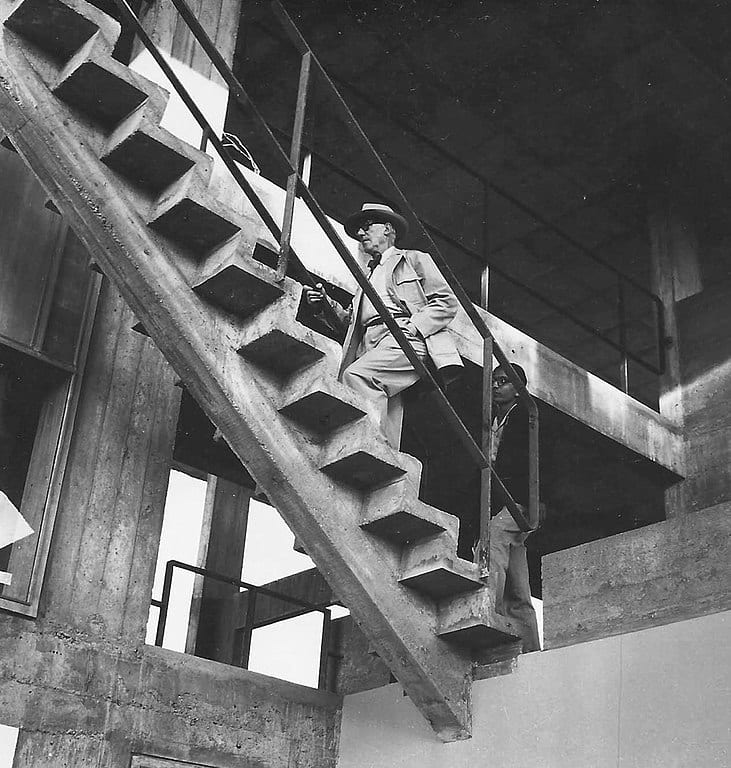



In 2008 or thereabouts, I made an appointment to interview Balkrishna Doshi for a book I was writing on the Gujarati city of Ahmedabad. As one of the city’s most distinguished residents and also as an outsider (he was a native of Pune in Maharashtra) who had made Ahmedabad his home, I was curious about how he viewed the city.
Entering his office complex, Vastu Shilpa Sangath on the busy Thaltej Road was like arriving at an oasis after a long trek through a desert. Curved vaults with unplastered walls stood amidst greenery pitted with a leaf-strewn pond. It was an apposite setting for Doshi’s opening comments about the city: “Living simply is the characteristic of this place: sand around and not much rain, such constraints make you think of frugality, make you very astute.”
I had read a book published by his Vastu Shilpa Foundation, The Ahmedabad Chronicle: Imprints of a Millenium which catalogued the many architectural styles co-existing in the city, one of India’s oldest urban spaces. I noticed that Doshi’s office buildings were designed to funnel hot air, much like pole houses in the old, walled city. Dappled sunlight on ridged ground reminded me of Sultanate mosques while the air of quiet grandeur, despite its lack of adornment, had a touch of the Moghul era.
The overall effect though was unmistakably modern. A case study of Doshi’s studio listed the following influences: Le Corbusier, Alvar Aalto, F.L. Wright, Antonio Gaudi, Louis Kahn. Kahn and Corbusier had designed structures in Ahmedabad, notably the Indian Institute of Management and the Millowners Association building, respectively. Doshi himself trained with Corbusier in London after studying at the Sir JJ School of Architecture in Mumbai. His introduction to Ahmedabad was as a supervisor of Corbusier’s projects in the city in the 1950s.
 Doshi and Le Corbusier at Le Corbusier's Shodhan House. (Image via architectural-review.com/ Wikimedia Commons)
Doshi and Le Corbusier at Le Corbusier's Shodhan House. (Image via architectural-review.com/ Wikimedia Commons)
The 20th century masters had been invited to Ahmedabad by the city’s textile barons who were not only immensely wealthy but also unusually clued into global cultural trends. Gira Sarabhai, whose family owned the thriving Calico Mill and who founded the National Institute of Design had studied under Lloyd Wright, for instance.
The city’s mahajans were also public-minded. “They thought of themselves as ‘citizens of a place’ and wanted to spread the benefits of whatever they did to the community, the city and beyond, till everybody got a share of the pie,” Doshi observed.
Their progressiveness enabled Doshi to start the School of Architecture in 1966, which metamorphosed into the Centre for Environmental Planning and Technology. “I just had to mention it to Kasturbhai Lalbhai (a prominent Ahmedabad-based industrialist and head of the Ahmedabad Education Society) and funds were made available.” And once an idea was backed, “there was no interference”. Doshi felt the approach was intrinsic to Ahmedabad’s entrepreneurial culture: “look around the city, at transactions in shops, everywhere, all hinge on trust, it was the same here.”
Doshi’s response to my question about violence and change in Ahmedabad was mixed. He believed that globalization had added a new layer to his familiar city which he both liked and disliked; the solution to social divides according to him lay in economic betterment. At the time of the 2002 communal disturbance in Gujarat, he said he had mulled the possibility of relocating and rejected it because he felt Ahmedabad offered an openness to ideas and he found even its pragmatic nonchalance challenging. “They have a saying here,” he said, “which goes: 'anyone can wield the sambelu (a pounding stick); play it (like a flute) then we might say you have done something worth talking about!'”
Discover the latest Business News, Sensex, and Nifty updates. Obtain Personal Finance insights, tax queries, and expert opinions on Moneycontrol or download the Moneycontrol App to stay updated!